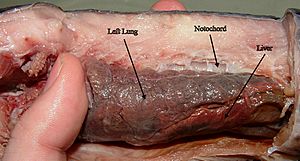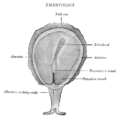Notochord facts for kids

The notochord is a flexible, rod-shaped part found in the early stages of all chordate animals. Think of it as a kind of early 'backbone' that helps support the body of a developing animal. It forms the main axis, or central line, of the embryo.
Contents
What is a Notochord?
The notochord is a special structure that looks like a flexible rod. It is found in the embryos of all animals belonging to a group called chordates. This group includes animals like fish, birds, reptiles, amphibians, and mammals (including humans!).
The notochord is located underneath the neural tube. The neural tube is what will later become the spinal cord and brain. So, the notochord helps support the developing nervous system.
Why is the Notochord Important?
The notochord was the very first "backbone" in the ancestors of many animals. It was a big step forward in evolution!
It gave early fish-like creatures a strong but flexible support for their bodies. This allowed their muscles to attach firmly, helping them to swim and move around. It was rigid enough to provide support but flexible enough for movement.
Notochord in Different Animals
In some chordates, like certain types of fish or primitive marine animals, the notochord stays throughout their entire lives. It acts as their main support structure.
However, in most vertebrates (animals with a backbone, like humans, dogs, and birds), the notochord is only temporary. During development, it is gradually replaced by the vertebral column. The vertebral column is made of many small bones called vertebrae. Even though it's replaced, the notochord plays a crucial role in guiding the development of the vertebral column.
Images for kids
-
Surface view of embryo of Concolor gibbon (Hylobates concolor).
See also
 In Spanish: Notocorda para niños
In Spanish: Notocorda para niños





